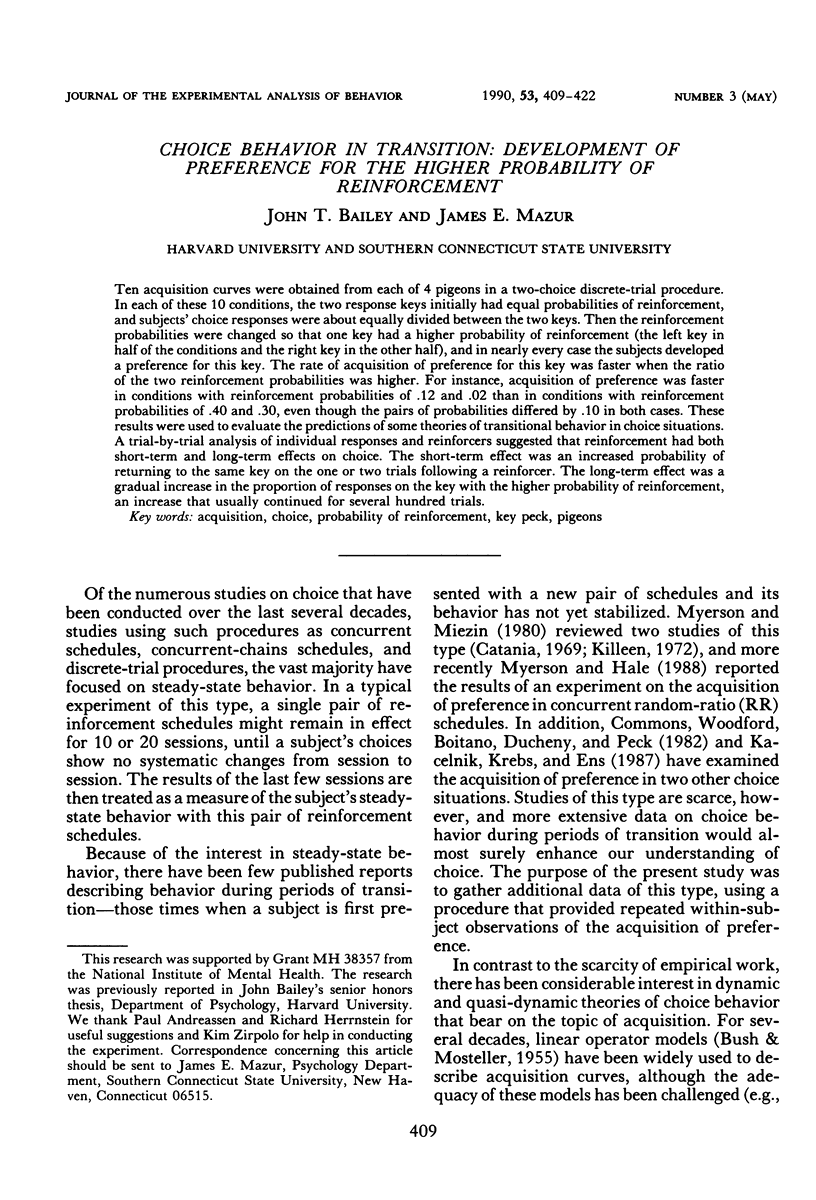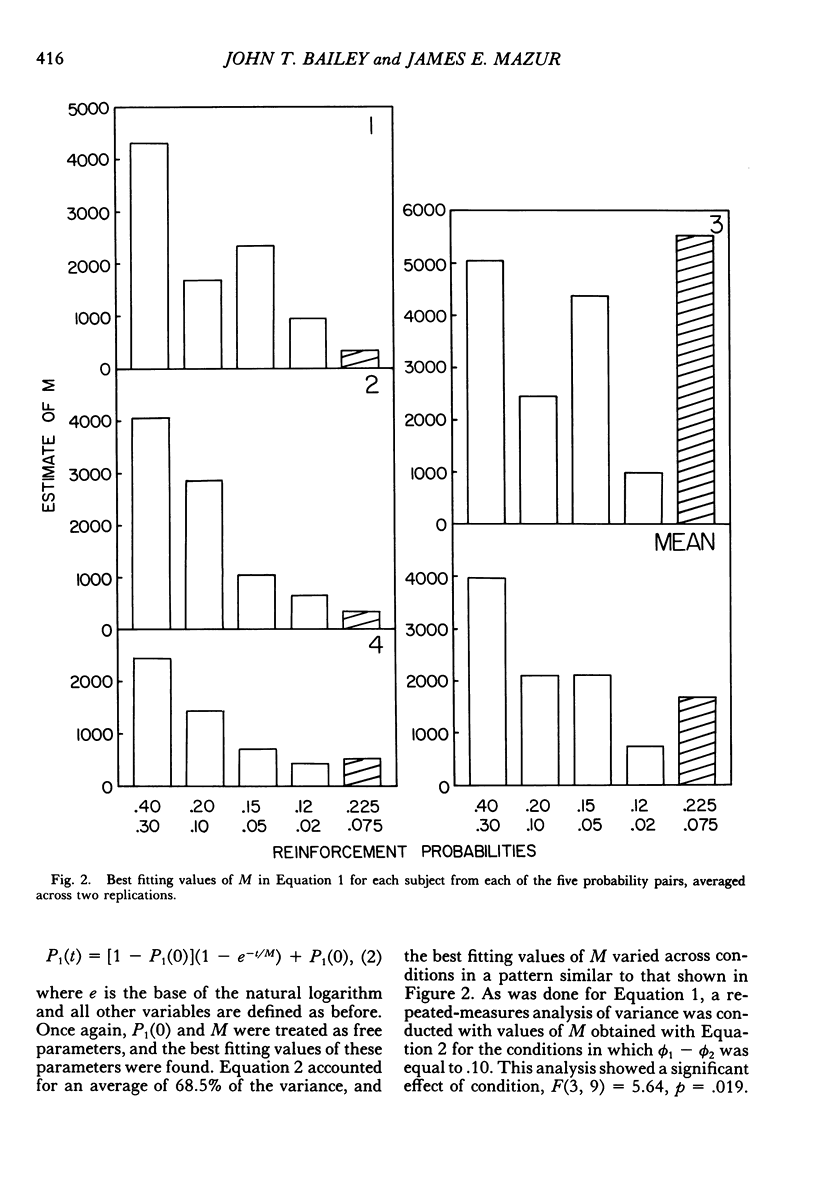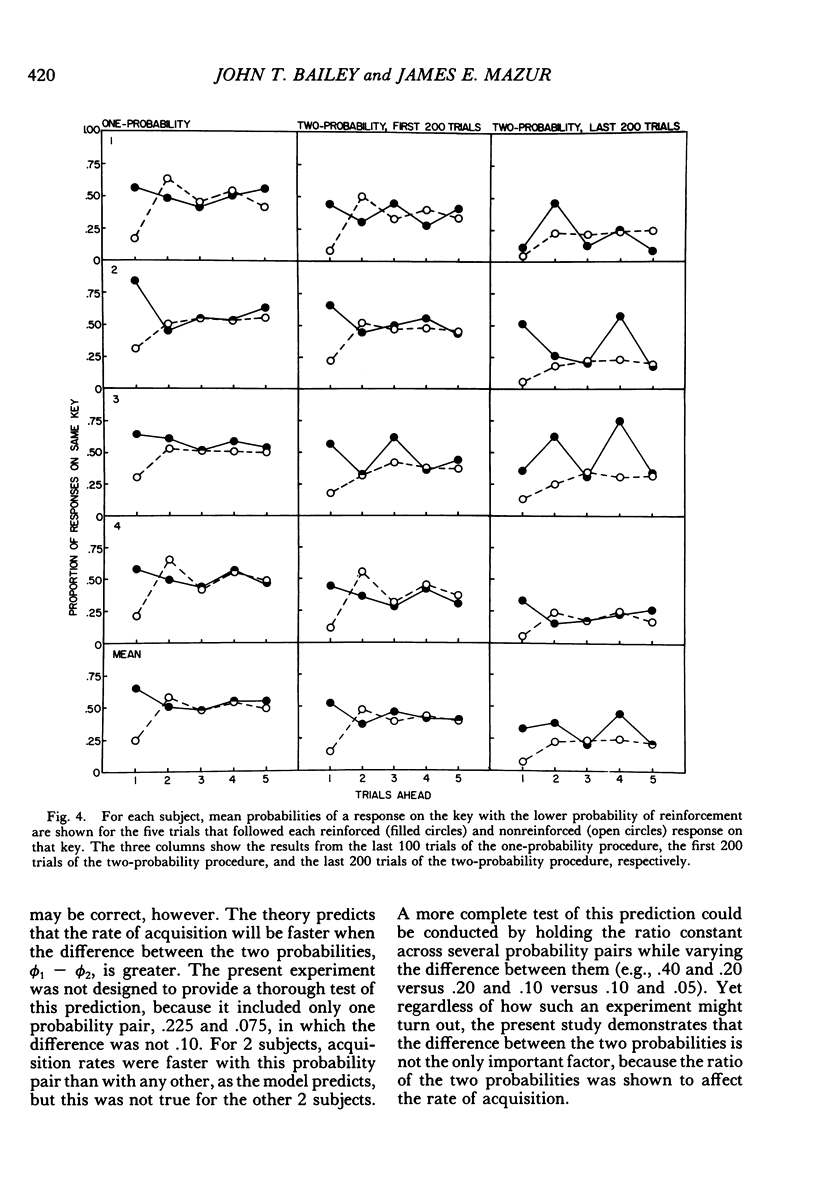Abstract
Ten acquisition curves were obtained from each of 4 pigeons in a two-choice discrete-trial procedure. In each of these 10 conditions, the two response keys initially had equal probabilities of reinforcement, and subjects' choice responses were about equally divided between the two keys. Then the reinforcement probabilities were changed so that one key had a higher probability of reinforcement (the left key in half of the conditions and the right key in the other half), and in nearly every case the subjects developed a preference for this key. The rate of acquisition of preference for this key was faster when the ratio of the two reinforcement probabilities was higher. For instance, acquisition of preference was faster in conditions with reinforcement probabilities of .12 and .02 than in conditions with reinforcement probabilities of .40 and .30, even though the pairs of probabilities differed by .10 in both cases. These results were used to evaluate the predictions of some theories of transitional behavior in choice situations. A trial-by-trial analysis of individual responses and reinforcers suggested that reinforcement had both short-term and long-term effects on choice. The short-term effect was an increased probability of returning to the same key on the one or two trials following a reinforcer. The long-term effect was a gradual increase in the proportion of responses on the key with the higher probability of reinforcement, an increase that usually continued for several hundred trials.
Full text
PDF













Selected References
These references are in PubMed. This may not be the complete list of references from this article.
- Catania A. C. Concurrent performances: inhibition of one response by reinforcement of another. J Exp Anal Behav. 1969 Sep;12(5):731–744. doi: 10.1901/jeab.1969.12-731. [DOI] [PMC free article] [PubMed] [Google Scholar]
- Fantino E., Royalty P. A molecular analysis of choice on concurrent-chains schedules. J Exp Anal Behav. 1987 Jul;48(1):145–159. doi: 10.1901/jeab.1987.48-145. [DOI] [PMC free article] [PubMed] [Google Scholar]
- Harley C. B. Learning the evolutionarily stable strategy. J Theor Biol. 1981 Apr 21;89(4):611–633. doi: 10.1016/0022-5193(81)90032-1. [DOI] [PubMed] [Google Scholar]
- Herrnstein R. J., Loveland D. H. Maximizing and matching on concurrent ratio schedules. J Exp Anal Behav. 1975 Jul;24(1):107–116. doi: 10.1901/jeab.1975.24-107. [DOI] [PMC free article] [PubMed] [Google Scholar]
- Killeen P. A yoked-chamber comparison of concurrent and multiple schedules. J Exp Anal Behav. 1972 Jul;18(1):13–22. doi: 10.1901/jeab.1972.18-13. [DOI] [PMC free article] [PubMed] [Google Scholar]
- Killeen P. Preference for fixed-interval schedules of reinforcement. J Exp Anal Behav. 1970 Sep;14(2):127–131. doi: 10.1901/jeab.1970.14-127. [DOI] [PMC free article] [PubMed] [Google Scholar]
- Mazur J. E., Hastie R. Learning as accumulation: a reexamination of the learning curve. Psychol Bull. 1978 Nov;85(6):1256–1274. [PubMed] [Google Scholar]
- Menlove R. L. Local patterns of responding maintained by concurrent and multiple schedules. J Exp Anal Behav. 1975 May;23(3):309–337. doi: 10.1901/jeab.1975.23-309. [DOI] [PMC free article] [PubMed] [Google Scholar]
- Morgan M. J. Effects of random reinforcement sequences. J Exp Anal Behav. 1974 Sep;22(2):301–310. doi: 10.1901/jeab.1974.22-301. [DOI] [PMC free article] [PubMed] [Google Scholar]
- Myerson J., Hale S. Choice in transition: A comparison of melioration and the kinetic model. J Exp Anal Behav. 1988 Mar;49(2):291–302. doi: 10.1901/jeab.1988.49-291. [DOI] [PMC free article] [PubMed] [Google Scholar]
- Nevin J. A. Interval reinforcement of choice behavior in discrete trials. J Exp Anal Behav. 1969 Nov;12(6):875–885. doi: 10.1901/jeab.1969.12-875. [DOI] [PMC free article] [PubMed] [Google Scholar]
- Staddon J. E., Horner J. M. Stochastic choice models: A comparison between Bush-Mosteller and a source-independent reward-following model. J Exp Anal Behav. 1989 Jul;52(1):57–64. doi: 10.1901/jeab.1989.52-57. [DOI] [PMC free article] [PubMed] [Google Scholar]
- Staddon J. E. Quasi-dynamic choice models: Melioration and ratio invariance. J Exp Anal Behav. 1988 Mar;49(2):303–320. doi: 10.1901/jeab.1988.49-303. [DOI] [PMC free article] [PubMed] [Google Scholar]
- Stubbs A. The discrimination of stimulus duration by pigeons. J Exp Anal Behav. 1968 May;11(3):223–238. doi: 10.1901/jeab.1968.11-223. [DOI] [PMC free article] [PubMed] [Google Scholar]
- Vaughan W. Choice: A local analysis. J Exp Anal Behav. 1985 May;43(3):383–405. doi: 10.1901/jeab.1985.43-383. [DOI] [PMC free article] [PubMed] [Google Scholar]


